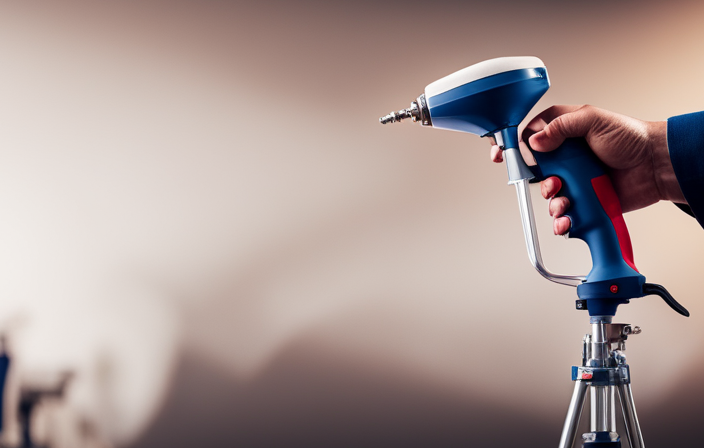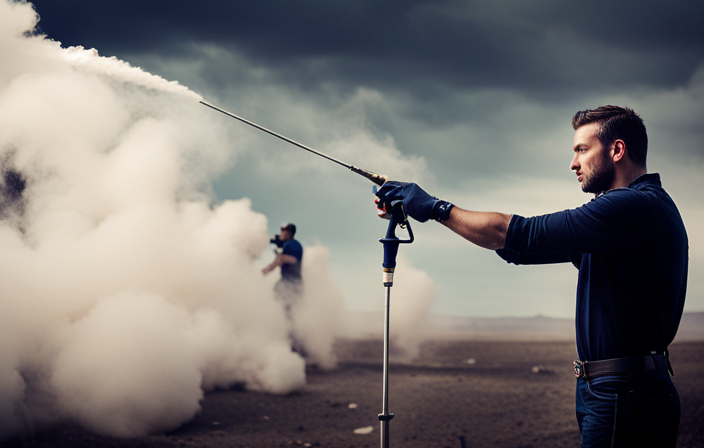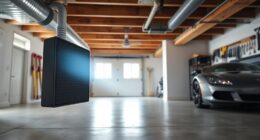The expression, “A paint sprayer is worth a thousand brushes,” really resonates with me. Are you tired of spending hours painstakingly painting every tiny detail? If so, now is the ideal moment to benefit from the efficiency of an airless paint sprayer.
This versatile tool is a game-changer when it comes to achieving professional-looking results in a fraction of the time. In this article, I’ll guide you through the ins and outs of using an airless paint sprayer, from understanding the basics to mastering proper technique.
We’ll cover everything from preparing your work area and choosing the right paint, to maintaining a steady pace and overcoming common challenges. Plus, I’ll share essential tips on cleaning up and storing your sprayer to ensure its longevity.
So, let’s dive in and unlock the secrets of using an airless paint sprayer like a pro.
Key Takeaways
- Proper cleaning and maintenance of the sprayer is essential for its performance and longevity.
- Disassembling and cleaning removable parts, such as the nozzle, is necessary to remove paint residue.
- Thoroughly cleaning the sprayer after each use prevents paint buildup and clogging.
- Following the manufacturer’s instructions for winterizing the sprayer is important to protect it during colder months.
Understand the Basics of an Airless Paint Sprayer
If you’re new to using an airless paint sprayer, it’s important to grasp the fundamentals before diving in.
An airless paint sprayer is a powerful tool that uses high pressure to atomize paint and propel it onto surfaces. Unlike traditional sprayers, it doesn’t require compressed air, making it more efficient and convenient.
One of the benefits of using an airless paint sprayer is its ability to cover large areas quickly and evenly. It also allows for a smooth finish and reduces overspray.
However, like any tool, it can encounter issues. Common airless paint sprayer troubleshooting includes clogged spray tips, uneven spray pattern, and excessive paint buildup.
To prevent these problems, it is essential to prepare your work area properly, ensuring it is clean and free from any obstructions.
Prepare Your Work Area
First, make sure your workspace is all set up and ready to go. Before using an airless paint sprayer, it’s crucial to prepare your work area properly. Start by removing any furniture, decorations, or objects that might get in the way.
Cover the floor and surrounding surfaces with drop cloths or plastic sheets to protect them from overspray. It’s also important to ensure good ventilation by opening windows or using fans to circulate the air. Additionally, wearing personal protective equipment, such as safety goggles, gloves, and a respirator, is essential to prevent any potential harm.
Taking these work area setup and safety precautions will help create a safe and efficient environment for using an airless paint sprayer.
Now, let’s move on to choosing the right paint and equipment.
Choose the Right Paint and Equipment
To achieve professional results and make your project a breeze, it’s crucial to select the perfect paint and equipment.
When choosing the right paint color, consider the type of surface you’ll be painting and the desired finish. For example, if you’re painting a high-traffic area, you may want to opt for a durable and washable paint.
Additionally, selecting the appropriate spray tip size is essential. A smaller tip size will provide finer atomization for thin materials, while a larger tip size is better suited for thicker coatings.
By matching the paint color and selecting the right spray tip size, you can ensure a smooth and even application with your airless paint sprayer.
Now, let’s move on to preparing the paint for spraying.
Prepare the Paint for Spraying
Now that you’ve selected the perfect paint and equipment, let’s dive into preparing the paint for spraying.
To ensure optimal performance, it’s crucial to mix the paint thoroughly. Use a stirring stick or paint mixer attachment to achieve a consistent color and texture.
Next, evaluate the viscosity of the paint. Most airless sprayers require thinning to achieve proper atomization. Thin the paint by adding small amounts of water or paint thinner until it reaches the manufacturer’s recommended consistency.
Here are three key points to consider when preparing the paint for spraying:
- Mix the paint thoroughly to achieve a consistent color and texture.
- Evaluate the viscosity of the paint and thin it if necessary.
- Follow the manufacturer’s guidelines for thinning ratios and proper mixing techniques.
With the paint properly prepared, it’s time to practice proper technique for achieving flawless results.
Practice Proper Technique
Once you’ve got the hang of mixing and thinning the paint, it’s time to dive into the fun part – practicing proper technique for achieving flawless results.
The key to using an airless paint sprayer effectively is to maintain a proper grip and have control over the spray pattern. Start by holding the sprayer with a firm but comfortable grip, keeping your wrist straight to ensure stability. This will allow you to have better control over the direction and movement of the sprayer during painting.
Additionally, pay attention to the spray pattern control knob and adjust it according to the surface you’re painting. A wider spray pattern is ideal for large areas, while a narrower pattern works well for detailed work.
With these techniques mastered, you’re ready to start painting and transform your space with a professional finish.
Start Painting
Begin your painting journey with the airless paint sprayer, like a skilled artist wielding a magic wand, bringing color and life to your space.
To achieve a smooth finish, follow these tips:
- Hold the sprayer nozzle at a consistent distance from the surface, usually around 12 inches.
- Keep your arm moving in a steady, fluid motion to avoid uneven application.
- Apply the paint in thin, even coats, overlapping each pass slightly for complete coverage.
Troubleshooting common painting issues:
- If the paint is splattering or dripping, check the viscosity of the paint and adjust accordingly.
- If the paint is not sticking properly, clean the surface thoroughly and ensure it’s dry before painting.
- If the paint is coming out unevenly, check the sprayer’s pressure settings and adjust as needed.
Maintain a steady pace as you paint, ensuring each stroke is deliberate and controlled. This will help you achieve a professional-looking finish.
Maintain a Steady Pace
To achieve a professional-looking finish, it’s important to maintain a steady pace while painting with the airless paint sprayer. This means maintaining consistency in your movements and avoiding overspray.
To maintain consistency, keep a steady hand and move the sprayer in a smooth, controlled manner. Avoid jerky or uneven motions that can result in an uneven coat of paint. Additionally, be mindful of the speed at which you’re moving the sprayer. Moving too quickly can result in overspray, which can lead to a messy and uneven finish.
By maintaining a steady pace, you can ensure that the paint is applied evenly and smoothly.
Now, let’s move on to overcoming common challenges in using an airless paint sprayer.
Overcome Common Challenges
Now that we’ve discussed the importance of maintaining a steady pace when using an airless paint sprayer, let’s move on to overcoming common challenges that may arise during the process.
One of the most common issues is clogging, which can be frustrating and time-consuming. To overcome clogging problems, it’s essential to regularly clean and inspect the sprayer’s filters and nozzles.
Another challenge you may encounter is spray pattern problems, such as uneven coverage or drips. Troubleshooting these issues involves adjusting the pressure and ensuring the nozzle is properly aligned. By following these troubleshooting techniques, you can achieve a consistent and smooth spray pattern.
In the next section, we’ll discuss how to clean up properly after using an airless paint sprayer, ensuring the longevity of your equipment and maintaining a professional finish.
Clean Up Properly
Ensure a stress-free and hassle-free clean-up by properly tending to the aftermath of your paint spraying adventure, allowing your equipment to bask in a well-deserved spa day. To achieve proper storage and maintenance, follow these cleaning techniques:
- Begin by removing the paint container and draining any remaining paint.
- Use a clean cloth or paper towel to wipe off excess paint from the sprayer’s exterior.
Fill a bucket with warm soapy water and run it through the sprayer to remove any paint residue.
- Disassemble the nozzle and other removable parts, cleaning them thoroughly with a brush and soapy water.
- Rinse all the parts with clean water and allow them to air dry before reassembling.
By following these steps, you can ensure that your airless paint sprayer remains in optimal condition for future use.
Transitioning into the next section, let’s now explore how to store and maintain your sprayer.
Store and Maintain Your Sprayer
Properly caring for your sprayer is like giving it a cozy home, ensuring it’s always ready for your next painting project. Sprayer maintenance and storage are essential to prolong its lifespan and maintain optimal performance. After each use, clean the sprayer thoroughly to prevent paint buildup and clogging. Once cleaned, it’s important to store the sprayer in a cool, dry place, away from extreme temperatures and direct sunlight. To ensure proper storage, follow these guidelines:
| Maintenance Tips | Storage Tips |
|---|---|
| – Regularly inspect and replace worn or damaged parts. | – Store the sprayer in an upright position to prevent leaks. |
| – Lubricate moving parts to prevent rust and ensure smooth operation. | – Keep the sprayer away from children and pets. |
| – Check and clean the filters regularly to maintain proper spraying. | – Store the sprayer in its original case or cover it to protect from dust and debris. |
| – Follow manufacturer’s instructions for winterizing the sprayer. | – Avoid storing the sprayer near flammable materials. |
By following these sprayer maintenance and storage tips, you can ensure that your airless paint sprayer remains in excellent condition, ready for your next painting venture.
Frequently Asked Questions
Can an airless paint sprayer be used for any type of paint?
An airless paint sprayer can be used with various types of paint, including latex, oil-based, and acrylic. To ensure optimal performance, it is important to clean and maintain the sprayer regularly, following manufacturer guidelines for best practices.
How do I prevent overspray when using an airless paint sprayer?
To prevent overspray when using an airless paint sprayer, make sure to adjust the spray pattern and pressure appropriately. Hold the sprayer at the correct distance from the surface and use masking tape to protect areas that should not be painted.
Is it necessary to thin the paint before using it in an airless paint sprayer?
No, it is not necessary to thin the paint before using it in an airless paint sprayer. The paint viscosity should be suitable for spraying. However, if needed, there are alternative thinning methods available.
Can an airless paint sprayer be used for small touch-up jobs?
Yes, an airless paint sprayer can be used for small touch-up jobs. It is a convenient and efficient tool for applying paint to small areas. However, there are alternative paint application methods and touch-up techniques available as well.
How do I prevent clogging in the nozzle of an airless paint sprayer?
To prevent clogging in the nozzle of an airless paint sprayer, regular maintenance is key. This includes cleaning the sprayer after each use, using a filter to remove debris, and using the correct paint viscosity. Troubleshooting nozzle clogs is essential for smooth operation.
Conclusion
So that’s it! Using an airless paint sprayer is all about understanding the basics and preparing your work area. You’ll also need to choose the right paint and equipment and prepare the paint for spraying. Practice proper technique, maintain a steady pace, and overcome common challenges. Afterward, clean up properly and store and maintain your sprayer. By following these steps and staying focused, you’ll be able to achieve professional-looking results in no time. So go ahead, grab your airless paint sprayer, and start transforming your space with ease and efficiency.










